Two weeks ago I ran a personal best in the half marathon at the Barcelona half (1h 20’ 47”). In this blog, I cover my training leading up to the race, and the race itself:
Training:
overview
weekly totals
key workouts
passive heat acclimation
training intensity distribution
Resting physiology:
heart rate and caloric restriction
HRV and stress
The race:
fueling
pacing
Training
Overview
After the Amsterdam marathon on October 15th (report here), I planned to keep building towards my main event, the 100 km del Passatore, while doing very limited racing (only this half marathon, and the Boston marathon). These races are just intermediate steps towards my main goal, not something I train specifically for, which explains some of the data you will see below (i.e. the high volume, high weekly elevation gain, and very long runs that are not really typical of half-marathon training, so to speak).
In the image below, you can see all the individual runs. I came up with this visualization as a way to quickly capture both the volume of training and consistency of workouts, which are the two main aspects of (my) training.
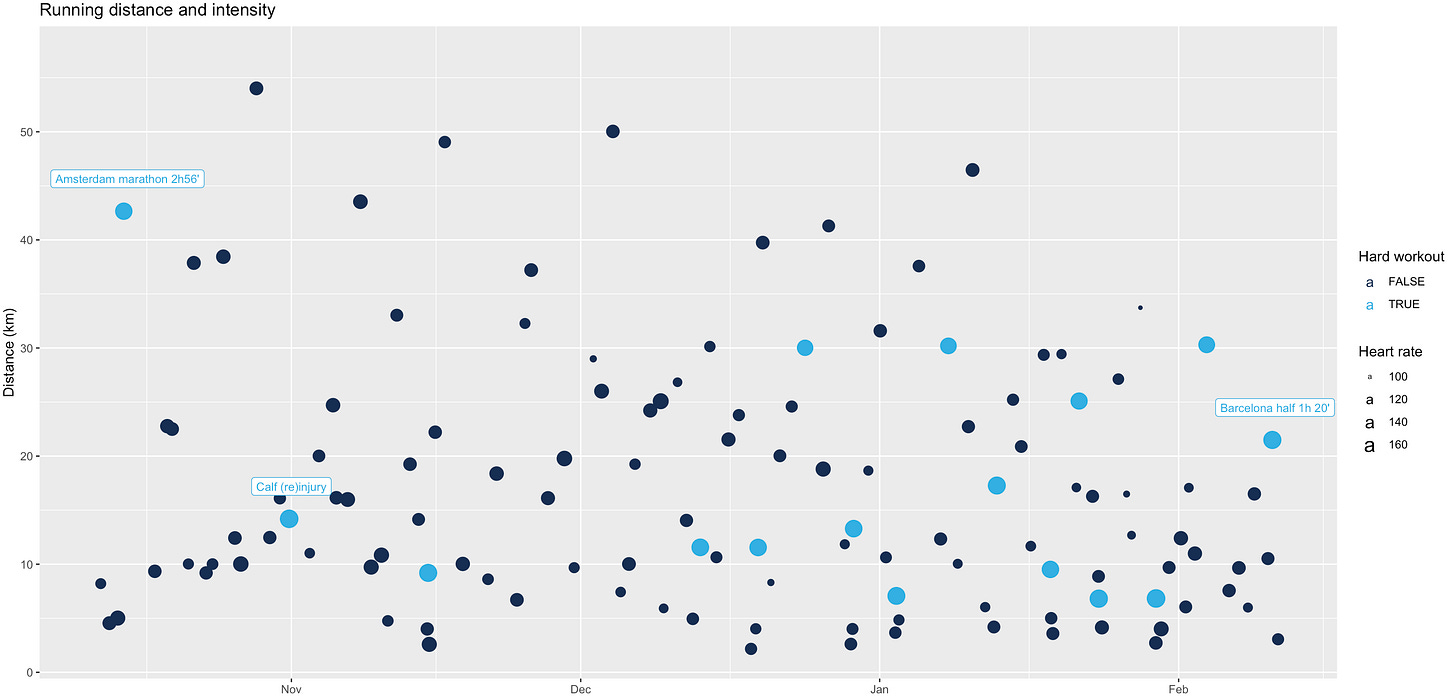
As I struggle to be consistent with intensity, this visualization makes it easy to capture when I can do my workouts for a few weeks in a row (e.g. in the second part of the graph here) and when I am not able to do so (e.g. in the first half of the graph here).
I have annotated a few events above: the marathon in October, then a calf (re)injury during a short race a few weeks later, and finally the Barcelona half marathon. We can see quite well how I was able to pick up hard training consistently only from mid-December. I am quite happy with this honestly, knowing my history, 2 months of consistent hard workouts can be a rare occasion (here are some of the steps I’m taking to make this happen more in the future).
The same data but with elevation gain as the dot size, instead of heart rate:
Racing can be a lot of fun, and I do care about my performance from time to time, but at the end of the day, for me, racing is mostly an excuse to get as fit as I can, so that I can increase the frequency of those dots you see up top: 5-10 hours adventures.
Not all my choices have performance in mind, there’s the mental health side of things, and there’s what I like doing, all of it becomes part of how I decide to train.
Weekly totals
Below is my weekly running and cycling distance during the period between the Amsterdam marathon and the Barcelona half marathon. You can see the peak in cycling just after the calf (re)injury, but otherwise, it has been mostly a running period, as I tend to cycle more with warmer weather or longer days (or when desperate because I am running injured). I still went out on the bike once per week on most weeks, as I do not run every day of the week (yet another attempt to stay healthier).
and the weekly elevation gain:
The 100 km del Passatore is a hilly, long race, hence I try to keep working on my hills and long distances all year round, while still targeting shorter races as I build fitness. The last few months before the race will include a lot more specific training (race pace, heat, even longer long runs), but the main ingredients are always there.
Overall, despite the many niggles and muscular issues, I was quite happy with the amount and quality of training. I felt like I could (and wanted to) race just below 1h 21’, and indeed I ran 1h 20’ 47” (just ask my friend Dave for my prediction the day before the race).
When you do the right key workouts, there isn’t much that you don’t know about how hard you can race. It becomes quite predictable, especially for a relatively short race like a half marathon.
Let’s get to the workouts then.
Key workouts
Since last summer, I stopped using a linear or block periodization (i.e. blocks of VO2max, followed by threshold and then steady-state while building for a marathon, which means from the least to the most specific as we progress), and started cycling through workouts types over a 2-week period.
I think I can stay healthier by doing a bit of everything all year round. Additionally, I think it is important not to neglect parts of training that are important for my main events, and that I am very bad at, in terms of genetic predisposition (e.g. long tempo runs, and anything that has to do with running economy and durability, see here for some data to back the statement above). Therefore, my current periodization and key workouts reflect this approach, which is quite different from what I did in preparation for my previous half marathons and marathons.
I do try to progress through workouts as I go from e.g. the off-season to an intermediate race, either increasing the number of reps or the duration of each rep or the pace, but there can be changes also just based on how I feel or how many physical issues I’m dealing with, or work stress.
November:
8 x 3’ hard, 2’ easy
15’ at threshold
7 x 2’ hard, 2’ easy
60’ tempo (marathon intensity)
December:
5 x 2000m hard, 2’ easy
10 x 3’ hard, 2’ easy.
30 km tempo
4 x 3000m hard, 2’ easy
January:
6 x 800m hard, 400m easy
30 km tempo (bad day, probably too low on calories)
4 x 4000m hard, 2’ easy
8 x 800m hard, 400m easy
February:
5000m at threshold (meant to be a 3 x 5000m but I felt poorly and called it a day)
3 x 2000m hard, 2’ easy
30 km tempo
Barcelona half marathon
As you can see, there’s a bit of everything each month. I executed well all sessions but two, probably for the same reason (see below in the resting physiology section for more details).
I’d be very happy if I was able to keep this up for more months. It is really not much, typically just one workout per week, but it tends to be quite a good stimulus, and I respond really well to this single session when there’s a lot of volume around it, as shown by how my performance has kept improving in the past 2 years.
For more details:
Passive heat acclimation
I used a passive heat acclimation protocol last year in preparation for Passatore (which was however canceled due to the floods in our region), as the race can be very hot. As the race was getting closer, I felt like I could do a lot better than I would normally do in the heat, at least in terms of perceived exertion and heart rate. For this year, I thought I’d try to do this also in winter, for two reasons:
as someone who struggles in the heat, I wonder if getting a bit of this stimulus all year round makes it easier to deal with it when summer comes
research has shown that heat exposure might improve performance in temperate conditions too, hence the protocol could give me an extra boost for the race
Obviously, I have no way to test the second point here, but that's just how it is.
In terms of protocol, I did the following:
5 times 20-25’ per week (normally Monday to Friday), hot bath (should be 40C but I did not measure, I normally look at my heart rate as an indicator of how hot it is and “how hard I’m working”).
2 weeks (end of December), then 2 weeks break, then 2 weeks again (last 2 weeks of January), then another 2 days (the week before the race). 21 sessions total (I did only 4 one week as I felt poorly for a few days due to probably not eating enough).
Last year I did all my sessions in the evening, while this time I did them right after training (as recommended, since core body temperature is already elevated by training).
Training intensity distribution
Below is my training intensity distribution during this period, something I discussed in my recent post on training zones, here. I spend much of my time in Zone 1, at or below 125 bpm (~65% of my maximal heart rate). This is not prescriptive, see the blog just mentioned for more details.
We can also see a decent amount of high-intensity work too, which are all the workouts listed above.
Here are the training zones (approximated, as I am looking at the average heart rate of each workout, not at second-by-second data):
Resting physiology
Below I look at resting heart rate and HRV collected using HRV4Training, first thing in the morning, while sitting. This is the protocol I recommend to all endurance athletes, as it is more sensitive to your stress response.
Heart rate and caloric restriction
For my data, I find that heart rate mostly responds to my caloric intake. In particular, I tried to lose some weight after not paying too much attention for a bit too long, and slightly restricted calories at the end of November. As I did that, my heart rate went down, and initially, also my HRV increased. However, this time it didn’t really go well like last year. I struggled and I wasn’t dropping much weight, while my energies were all over the place. I had days I was barely able to work, days I could do a hard workout, and days I could barely hike, it was a mess. I kept it up for almost 2 months, but eventually gave up at the end of January, after two miserable training weeks in which I had to walk much of my training.
As soon as I started eating more again, my heart rate went up. Interestingly, HRV was already suppressed for a while. I wonder if heart rate just captured the caloric deficit, while HRV captured my issue in responding positively to the deficit.
Anecdotally, last year, when I lost more weight and had no energy issues, my HRV was the highest it had ever been (rMSSD in the 90s, while typically it is in the 60s).
HRV and stress
As it often happens, HRV captured quite well my negative stress response to various stressors. For example, I had the biggest reduction during a business trip to the UK and US, where I had to give a few talks, and in general, I was quite stressed.
I then had a long suppression and very high day-to-day variability for several weeks (this is the coefficient of variation, which I discuss here). I suspect here we are seeing how much I am struggling with the weight loss and caloric restriction combined with the hard training. Every two days I have a dip below my normal range, which is not what we’d like to see normally.
Finally, as I stop the caloric restriction, despite an increase in heart rate, HRV gets higher too. I have a final dip with a double hard session that was probably a bit too much for me, before re-normalizing in time for the race, with a very easy last week (in terms of training and non-training related stressors):
Below we look in more detail at the final suppression just before the race, a particularly heavy block, where I added a high-intensity session on the bike (the only one of the entire training period), after a hard running workout:
As I move towards the next training block, I will try to pay more attention to day-to-day variability and frequent suppressions, and see if I can do better in terms of adjusting caloric intake. It is not always so easy when we train at high volume and intensity, together with work commitments.
See also:
Heart rate variability (HRV) measurement position: lying down, sitting or standing?
Heart Rate Variability (HRV) measurement timing: morning or night?
The race
A half marathon is pretty easy to race, at least with respect to a marathon or an ultra, as nothing can really go wrong in a half marathon (unless you get injured with 200m to go). Brief section ahead.
Fueling
I opted for 2 Maurten gels with caffeine (100 mg each), one 10 minutes before the race, and one after about 8 km. I had a large breakfast 3 hours before the race (oatmeal and fruit). I also had plenty of carbs in the 48 hours before the race, but without overdoing it. More or less I had the same calories I would normally have, or a bit more, but mostly carbs.
Warmup
I jogged for about 20 minutes super slow. I feel like I am starting to need this before a race up to the half marathon, where the intensity is quite high and the pace is something very far from my daily running pace. The marathon is still slow enough that no warmup seems no problem.
Pacing
I thought I could run about 3’50”/km, based on my threshold workouts. I started running by feel, and once I found my rhythm, I looked at what pace I was hitting, which was in line with expectations. This is how I normally do my workouts too: I start by feel and slightly adjust based on what I know or think I can run. Then I hold the pace when perceived exertion starts to change, as it will naturally do.
The first half of the race was slightly slower, maybe about 10 seconds, with respect to the second half, as there were more hills and a bit of traffic in the first and second kilometers. Overall I am happy with pacing for this race.
In the second part of the race I felt like I had more in me from a cardiovascular point of view, but my hamstrings were really tight and I was terrified I’d pull one again, just like at the Cannes half marathon. I tried to still run hard to make it to sub 1h 21’, but without giving all I had. A bit of damage control. It then took me 4 days to be able to attempt a run again, due to hamstring pain. I am more and more delicate every year.
Given these issues I decided not to race anything shorter than a half marathon in the future, as the risk of breaking seems too high and just not worth it anymore. Fortunately, I do not seem to have any issues when I run at marathon pace.
p.s. never rely on your wearable’s made-up scores, especially on race day
That’s all for this race.
Next stop, Boston.
See you there?
Marco holds a PhD cum laude in applied machine learning, a M.Sc. cum laude in computer science engineering, and a M.Sc. cum laude in human movement sciences and high-performance coaching.
He has published more than 50 papers and patents at the intersection between physiology, health, technology, and human performance.
He is co-founder of HRV4Training, advisor at Oura, guest lecturer at VU Amsterdam, and editor for IEEE Pervasive Computing Magazine. He loves running.
Social:




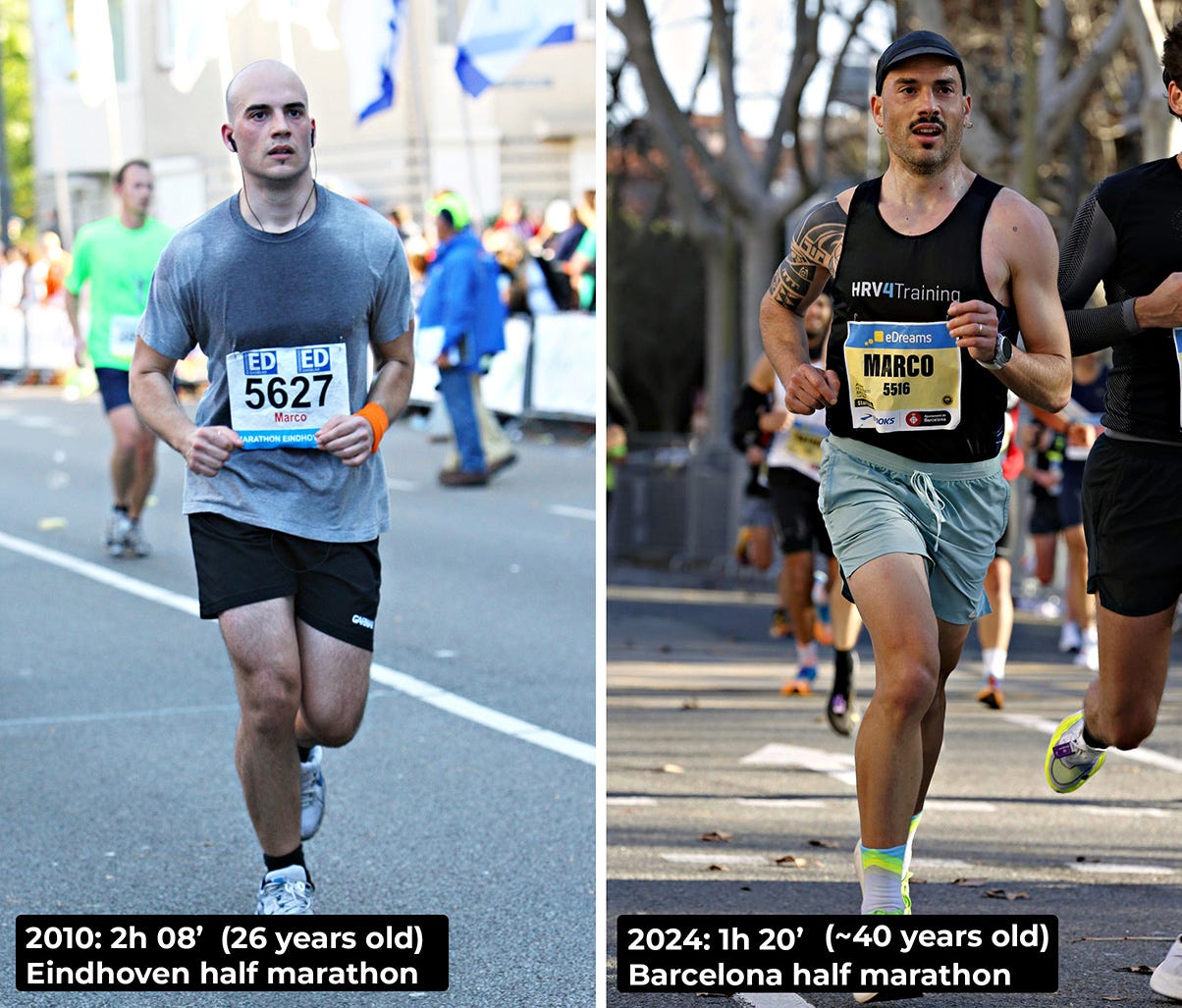

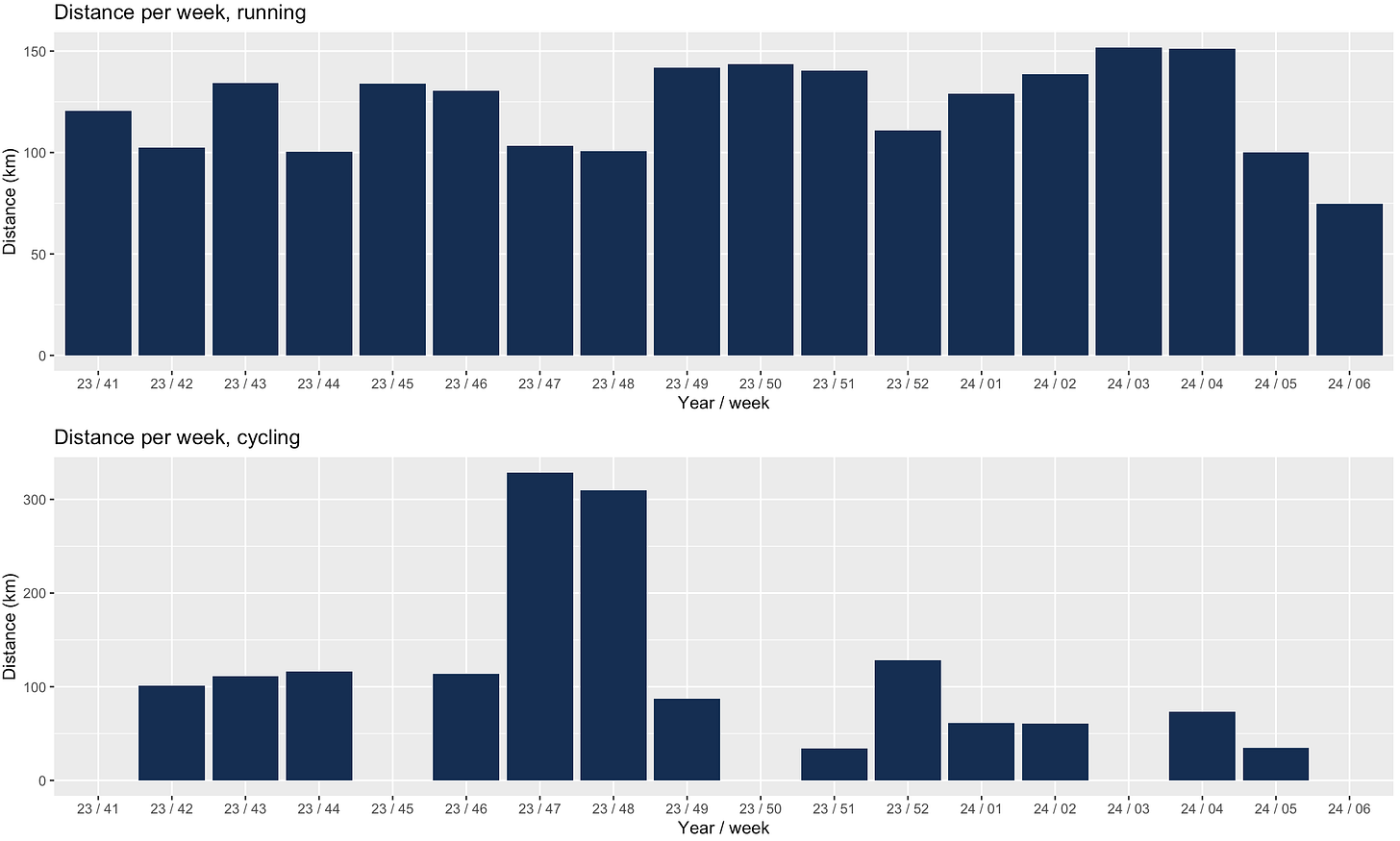



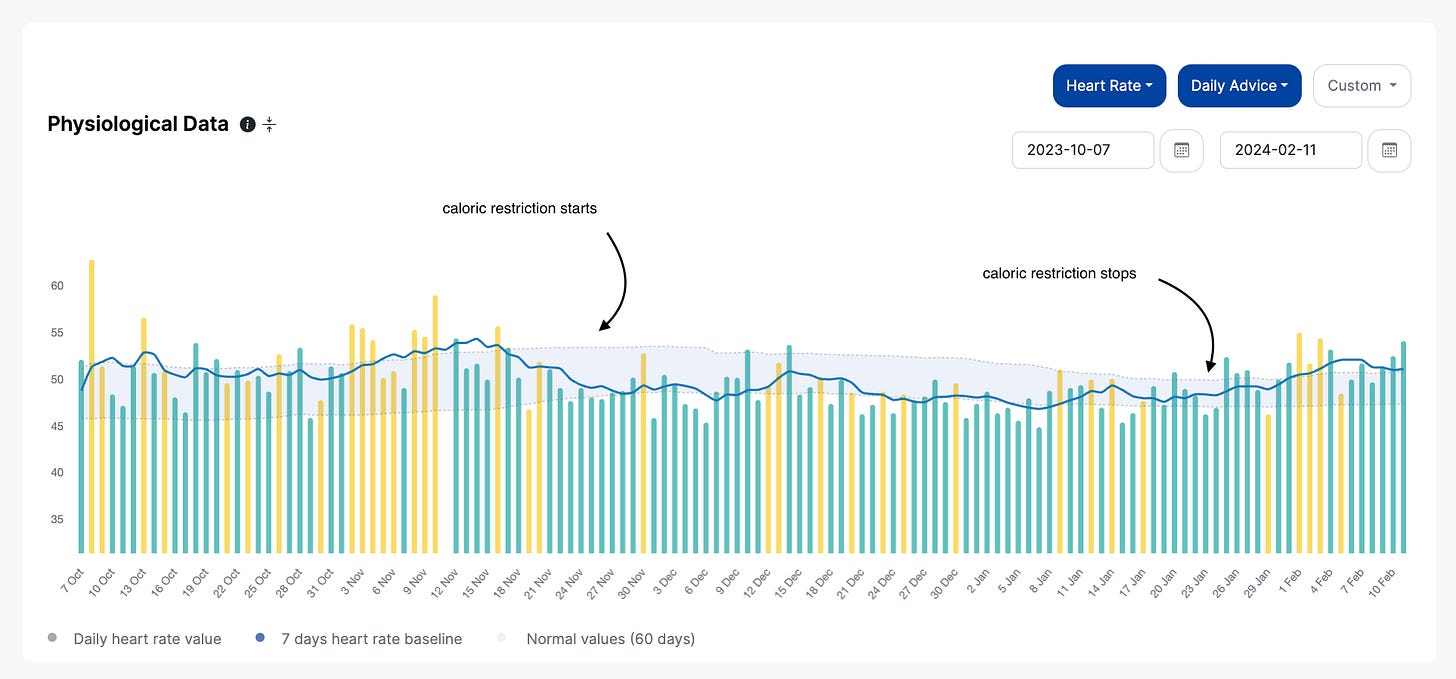
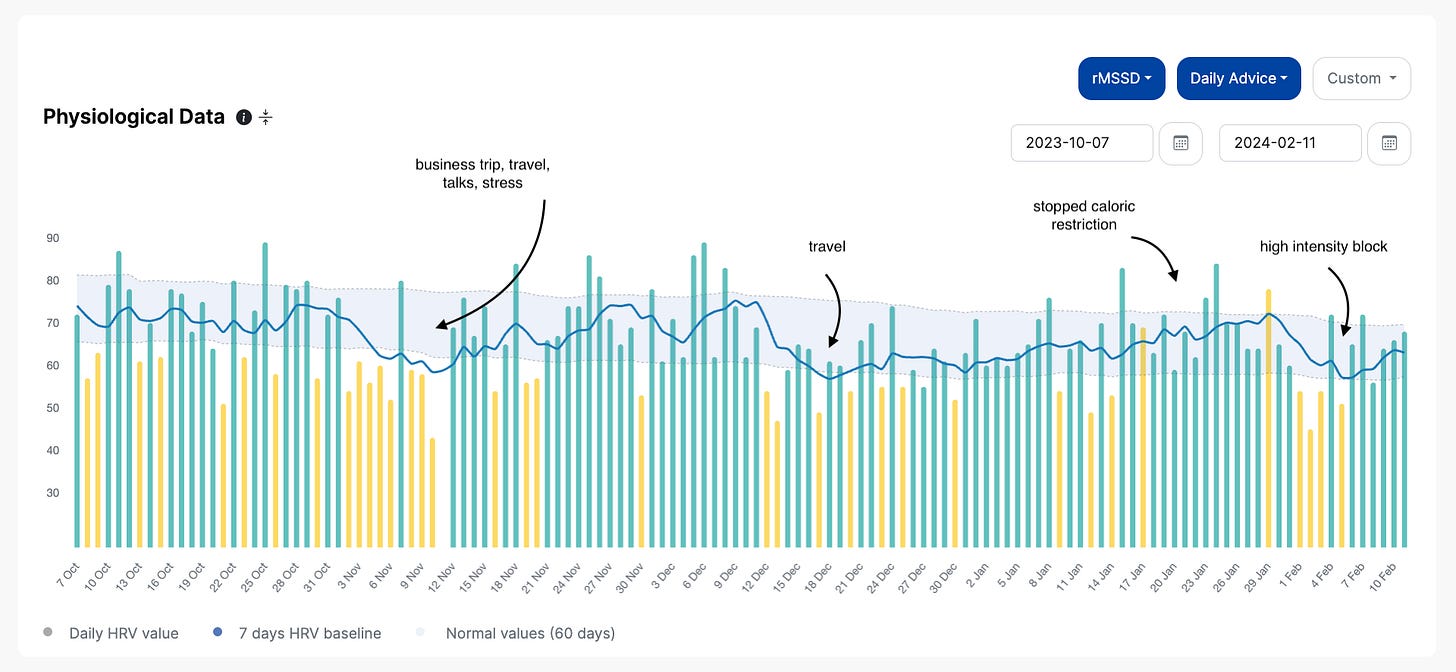
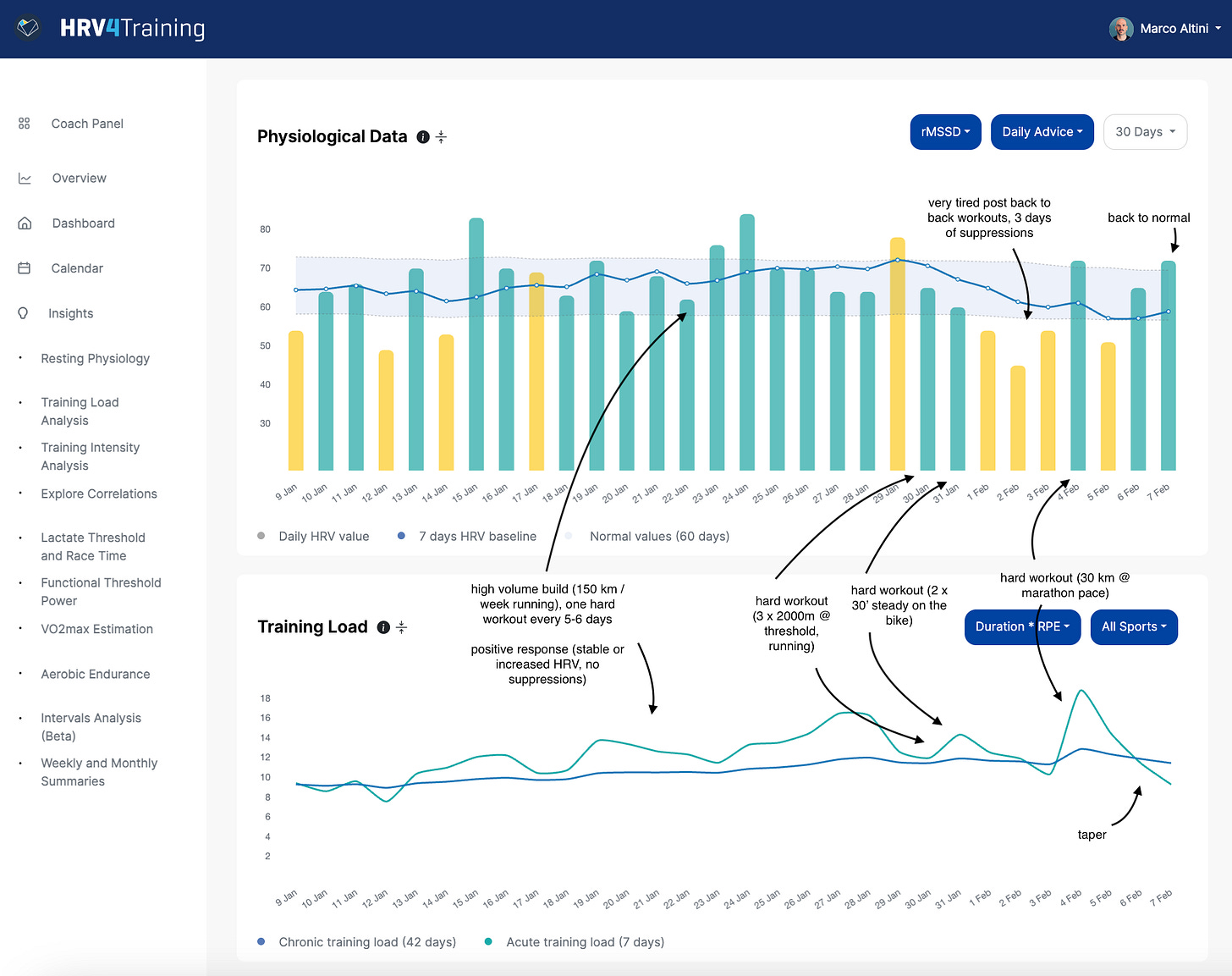



Congrats for this great personal achievment! I have the same approach in cycling, improving and stay healthy. If I understand well, the four sessions described every month are the ones where you do intensities? All others sessions are zone 1? Do you practice some intensities when you cycle?
It’s not so easy to do only one session per week with some intensity. I’m not prone to do frequently group rides but in that case, impossible to do a structured workout and only one session of intensity per week!
What could be a plausible link between being in a calorie deficit and lower heart rate?